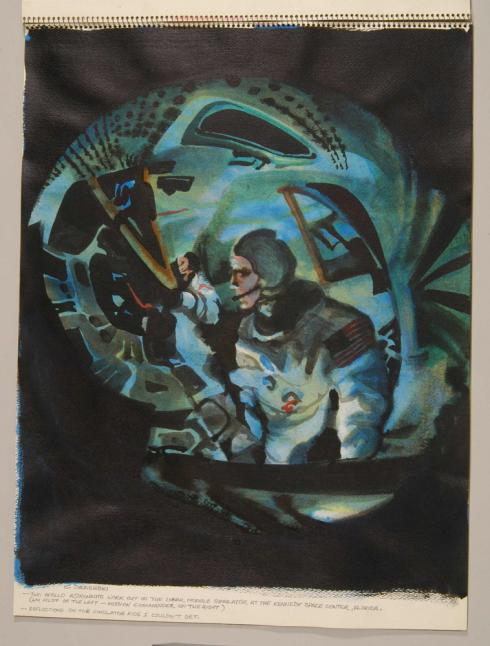In 1962, just four years after the National Aeronautics and Space Administration was created as a federal agency, James Webb established NASA’s Artist’s Cooperation Program.
Modeled after the U.S. Air Force’s art program, Webb hoped that the agency’s commission of fine art would help communicate the cultural significance of the space program’s initial advancements. Administrators still needed to sell the idea that traveling to the Moon was a possibility to the tax-paying American public. NASA believed that artistic interpretations of its projects would offer less fleeting narratives than newspaper or television coverage.
Meet The Artists
Throughout the Apollo program, a range of artists were given unrestricted access to NASA’s various facilities in order to collect usable reference materials.
Wyeth was the youngest participant of the NASA Art Program at nineteen years old. Wyeth selected a dangerously high location as his perch to paint the launch of Gemini IV on June 3, 1965. The flight marked America’s first spacewalk performed by Ed White, and it seems the adventurous teenage artist recreated the spacewalk feeling from his towering position. But how did he get access to this location?
"So they were incredibly open and wanting me to see everything, which was great."
From an outsider’s perspective, Lamar Dodd must have seemed like an unlikely choice for a commission to create paintings on the subject of space. Dodd was a regionalist artist; that is, his art aimed to capture the mood of specific landscapes and their people, not historic events. However, the art of the NASA program also had to do what press photographs alone could not: include a human perspective. In this case, Lamar Dodd was the perfect candidate. He had a knack for bringing a touch of humanity to unexpected subjects.
Artists like Robert McCall, Fred Freeman, and Robert Rauschenberg all participated in the program, lending their images and reputations to NASA’s public engagement efforts in the years leading up to the Moon landing. Norman Rockwell worked alongside the artists of the NASA Art Program.
Jamieson was known for his depictions of the onlookers at major events rather than the events themselves. This style allows the viewer to believe that they are there as part of the crowd, feeling the energy and excitement.
Chosen as the first artist for NASA’s Project Mercury, Mitchell Jamieson created works that evolved from enthusiastic images to darker ones that reflected the deep conflict he felt about American actions in Vietnam and Cambodia. Jamieson feared that NASA’s idealistic mission would be overtaken by military goals.
The Artwork
Custom Image Caption
Saturn Blockhouse
Fred Freeman
Acrylic on canvas
1968
As a participant in NASA’s art program, Fred Freeman gained unfettered access to space facilities during missions. Here, he shows us just how close he was, even depicting his coffee cup resting on the console.
Custom Image Caption
Firing Room
James Wyeth
Acrylic on paper
1969
James Wyeth’s cool blue rows of men behind computer monitors emphasized the calm rationality of the firing room, headquarters for Launch Control at the Kennedy Space Center, as technicians await a Saturn V launch.
Custom Image Caption
Lunar Liftoff of “Orion,” 20:26 EST, 23 April 72
Chet Jezierski
Pencil, brushed ink on paper
1972
Artists in the NASA art program chronicled nearly all aspects of Apollo missions. In one of his sketchbooks from his time at Mission Control in Houston, Chet Jezierski depicted some of the television images seen on the facility’s large screens.
These codices are part of a series of three created by artist Mitchell Jamieson after he observed the return of the Apollo 11 astronauts in 1969. One book contains Jamieson’s firsthand observations of the activities aboard the USS Hornet, the aircraft carrier sent to retrieve the astronauts from their ocean landing zone. The other represents Jamieson’s musings on humanity’s encounter with the lunar surface. Together they offer an intimate vision of this historic moment.
After the conclusion of the Apollo program, the need for commissioned art seemed less acute, and throughout the 1970s the art program slowed. In 1975, Jim Dean, a founder of the NASA art program, along with Lester Cooke, a curator of paintings at the National Gallery of Art, played a key role in bringing the collection to the Museum.

